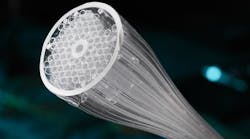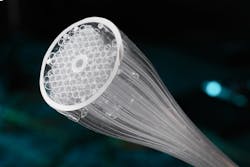At a Glance:
- Researchers at Ecole Polytechnique Fédérale De Lausanne in Switzerland are using air to amplify light across hollow-core optical fibers.
- The technology can be applied to any type of light—from infrared to ultraviolet, and to any gas.
- The technology could be used to make extremely accurate thermometers.
Researchers at Ecole Polytechnique Fédérale De Lausanne in Switzerland have developed a technology to amplify light inside newly developed hollow-core optical fibers.
Optical fibers are typically constructed with a solid glass core. Although light can travel along these fibers, it progressively loses half of its intensity after 15 kilometers, and by 300 kilometers the light is hardly detectable, according to Luc Thévenaz, the head of the Fiber Optics Group in EPFL’s School of Engineering.
It would be helpful to keep the light moving by amplifying it at regular intervals, but the solid core acts as an obstruction, said Thévenaz, whose workaround was to develop hollow-core optical fibers filled with either air or gas.
By using a gas-filled hollow-core fiber at high pressure, Thévenaz’s team achieved a strong Brillouin amplification across the length of the fiber that were comparable to six times the gains from a solid silica core. “The air means there’s less attenuation, so the light can travel over a longer distance,” he said. “That’s a real advantage.”
However, in a thin substance like air, the light is harder to amplify. “That’s the crux of the problem: Light travels faster when there’s less resistance, but at the same time it’s harder to act on. Luckily, our discovery has squared that circle,” Thévenaz said.
Fan Yang, a postdoctoral student working with Thévenaz, explained that the answer was to create controlled resistance by adding pressure to the air in the fiber. “It works in a similar way to optical tweezers—the air molecules are compressed and form into regularly spaced clusters,” Yang explained. “This creates a soundwave that increases in amplitude and effectively diffracts the light from a powerful source towards the weakened beam so that it is amplified up to 100,000 times.”
Using this new technique makes the light more powerful. The technology could also be used to create a temporary optical memory by stopping the light in the fiber for a microsecond (that’s 10 times longer than is currently possible), the researchers noted. Moreover, the technology can be applied to any type of light—from infrared to ultraviolet, and to any gas, they said.
In addition to light amplification, the researchers note the technology could be used to make extremely accurate thermometers and provides a way to measure temperature distribution at any point along the fiber.
“So, if a fire starts along a tunnel, we’ll know exactly where it began based on the increased temperature at a given point” added Flavien Gyger, a PhD student working on the project.
Findings for this research have been published in Nature Photonics. A video describing the technology can be found here.


